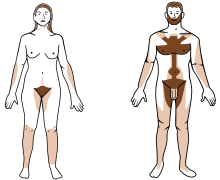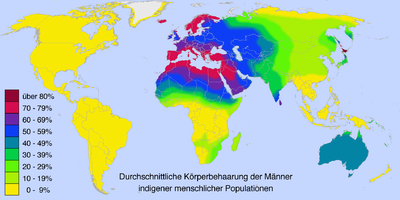body hair
When body hair is hair on the human body in contrast to the head hair called. With regard to androgen sensitivity, it follows different growth and development modalities than the scalp hair. With the exception of the beard hair in men, their growth cycle is limited to a few months and thus much shorter than that of the scalp hair. For example, leg hair falls out after two months , armpit hair after six months.
Since the terminal or adult body hair only develops through an increased release of androgens (male sex hormones ), it is sometimes also referred to as androgenic hair . Because of the different levels of androgen release in women and men, the terminal body hair develops in a gender-specific manner . It is therefore also considered a secondary sex characteristic .
development
With a few exceptions, the entire human body is covered with vellus hair , a marrowless, unpigmented fuzz. Through an increased release of androgens during and after puberty , vellus hair is converted into terminal hair in a gender-specific manner. The resulting terminal hair is medullary and individually pigmented. The degree of the respective body hair is next to the sex of the genetic disposition , the hormonal dependent status and of age.
First and foremost, the genetic disposition determines the individual expression and thus the extent of the hair. A certain number of hair growth cells are genetically determined in the skin.
Men and women do not differ in the number of hair growth cells. Only the different functions of the endocrine system, i.e. the proportion of androgens, determine the amount and density of hair growth. In some peoples women are also very hairy. Here it is not uncommon for hormonally healthy women to have a male hair type by Central European standards.
Distribution in human populations
The thickness of body hair varies across human populations . The cause is different evolutionary adaptation processes to different habitats in the course of human development. For example, the Malays often have no body hair and the Ainu have a strikingly large amount. It used to be a feature of outdated racial theories . Today we know that there are no clearly delineated races, only smooth transitions and large genetic ranges within each population. The adjacent map shows the distribution before the European expansion , but does not take into account that there are also differences in the body parts. For example, the Eskimos and Northwest Coast Indians have significantly more beard growth than other American indigenous peoples , while the rest of the body hair shows no significant difference.
function
In some parts of the body that are rich in sweat glands (for example on the armpits ), the terminal hair supports temperature regulation by increasing the surface area and allowing sweat to be released more easily. Other areas are additionally protected by the hair, for example the pubic area. Especially in the perianal and perigenital area, the body hair also serves to reduce friction.
Hair not only increases the surface area of the body, it also increases the sensitivity of the skin. There are some parts of the body that are erotically stimulated by being caressed - one speaks of erogenous zones of the skin. If you now touch the hair, this tactile stimulus is amplified many times over due to the enlarged surface. The hair transfers the contact to the skin, where there is an intensifying effect.
Another function is that the vellus hairs make an important contribution to the protection against blood-sucking ectoparasites : On the one hand, the above-mentioned amplifying effect, especially of the fine vellus hairs, detects crawling parasites such as ticks , mosquitoes or bed bugs faster and more effectively (detection function); on the other hand, bloodsuckers need significantly more time to find a suitable puncture point in the tangle of hair (barrier function).
Androgen sensitivity
Hair on the body reacts differently to androgens than hair on the head . In contrast to scalp hair, the growth of which decreases with increased androgen intake, the growth of body hair is stimulated. The development from vellus hair to terminal hair during puberty is based on this androgen sensitivity.
The androgen sensitivity of body hair is not only evident during puberty, but also with artificial androgen intake, for example through certain hormone preparations. Studies show that people who take steroid preparations , for example , develop increased body hair. Women in particular can develop hair similar to the male growth pattern when taking such preparations ( virilization , hirsutism ). The artificially increased androgen intake not only affects hair growth, but also damages the entire organism ( infertility , increasing risk of cancer , liver failure, and so on).
In women, body hair can also increase due to the falling estrogen level during menopause and the resulting androgen dominance. This can be counteracted by taking estrogen preparations.
Gender-specific hair patterns
Female body hair

During puberty, women develop terminal hair in the following areas:
- Pubic hair
- Anal hair
- Armpit hair
- Hair on extremities ( arms and legs )
Male body hair
In contrast to women, the man's body is covered by more terminal hair. Various parts of the male body have terminal hair growth that develops during and after puberty :
- Whiskers
- Chest hair
- Pubic and abdominal hair
- Anal hair
- Armpit hair
- Back hair
- Hair on extremities (arms and legs)
- Hair on the buttocks
- Nose hairs
- Ear hairs
The development of male body hair begins in the early phase of puberty, but continues even after the end of puberty and reaches its peak in the sixth decade of life. As a rule, it is even the case that on certain parts of the body such as the chest, upper arms, shoulders and back, fully developed terminal hair only develops between the ages of 20 and 30 or often never. The degree of body hair at the end of puberty therefore does not always correspond to the potential terminal state.
Increased body hair
An excessive and unnatural growth of body hair is called hypertrichosis . Hypertrichosis, which is medically defined as a disease, can occur in both women and men to different degrees and at different ages.
One form of increased body hair that only affects women is hirsutism , which manifests itself in the development of a male hair type that is atypical for women. Hirsutism is usually triggered by an increased release of male sex hormones.
Also atavism , the occasional expression of otherwise only embryonic-scale features can Vollgesichts- or Vollkörperbehaarung in adults have either sex result.
Cultural aspects
When hair is considered abnormal depends not only on medical, but also on social circumstances. The way in which body hair is viewed differs greatly between different cultures. In some cultures it is exhibited as a gender characteristic, in others the hairless body is considered an ideal. Body hair was removed or shortened as early as medieval Europe.
Between the 1980s and 2000s, there was an increasing tendency towards depilation of the body ( full body shaving , intimate shaving ) in the western industrialized nations , especially among women. In many cultures of modern times, excessive hair growth is still considered unaesthetic, especially in women, and product and wellness advertisements also confirm and support the constant trend towards smooth, hairless skin. The closer you wear a bathing suit or bikini , the more “must” be hairless under these cultural guidelines that which is shown on increased skin. Although the social acceptance of body hair is still much higher among men, a trend towards shaving can also be seen here. Removing body hair is less common in men than in women. A study carried out by the University of Leipzig in 2008 among young adults came to the conclusion that 97% of women and 79% of men remove at least part of their body hair.
There has been a movement against body hair removal since the mid-2010s. Women in particular spoke out against the social norm in social networks. Towards the end of the decade, the unshaven appearance was described by the media as a new trend and is also enjoying support in the advertising industry. A study by the British market agency Mintel looks at the development of body hair removal between 2013 and 2018 and shows that fewer and fewer young women shave in the corresponding body regions.
Web links
Individual evidence
- ↑ Why hair grows all the time. In: Wissenschaft.de. November 2, 2006, accessed on September 8, 2019 : "While leg hair ceases to grow and falls out after about two months and armpit hair about six months, the scalp hair continues to grow uninterrupted in a person for at least six years."
- ^ Joseph Deniker: The races of man: an outline of anthropology and ethnography. 1901
- ^ CH Danforth, M. Trotter: The distribution of body hair in white subjects. In: American Journal of Physical Anthropology. 5, 1922, pp. 259-265.
- ↑ The Psychology of Intimate Shaving. Psychologists are investigating reasons for body hair removal - 97 percent of young women and 79 percent of men shave. In: derstandard.at. November 25, 2008. Retrieved November 25, 2008 .
- ↑ Every second draws blank below. In: Blick.ch. November 30, 2005, accessed June 26, 2019 .
- ↑ No more fur! In: SPIEGEL ONLINE. June 18, 2007, accessed July 24, 2008 .
- ↑ Hairy considerations. About people's efforts to hide their affinity with the apes. In: literaturkritik.de. April 2011, accessed May 2, 2011 .
- ↑ Trend on social media: unshaven young women celebrate their armpit hair online. In: Focus Online . June 12, 2015, accessed August 31, 2016 .
- ↑ She hasn't shaved her legs for a year - BRAVO. In: bravo.de. June 12, 2015, accessed August 31, 2016 .
- ↑ Hella Brunke: Beautiful, fit, unshaven: The trend is towards unshaven legs. In: girls . April 18, 2017, accessed July 12, 2020 .
- ↑ Katja Mitic: Unshaven, everywhere: "When I shave my legs, I feel powerless". In: The world . April 30, 2017, accessed July 12, 2020 .
- ↑ Jana Sepehr: Manufacturer of women's shavers dares to show real hair in the commercial. In: Global Citizen . June 20, 2018, accessed July 12, 2020 .
- ↑ Viktoria Graf: #Bringbackthebush : Intimate hair as a new trend? In: Kronen Zeitung . June 17, 2019, accessed July 12, 2020 .
- ↑ Brooke McCord: In 2019, Are People Still Shaving Their Bodies? In: Dazed. February 2019, accessed July 12, 2020 .





